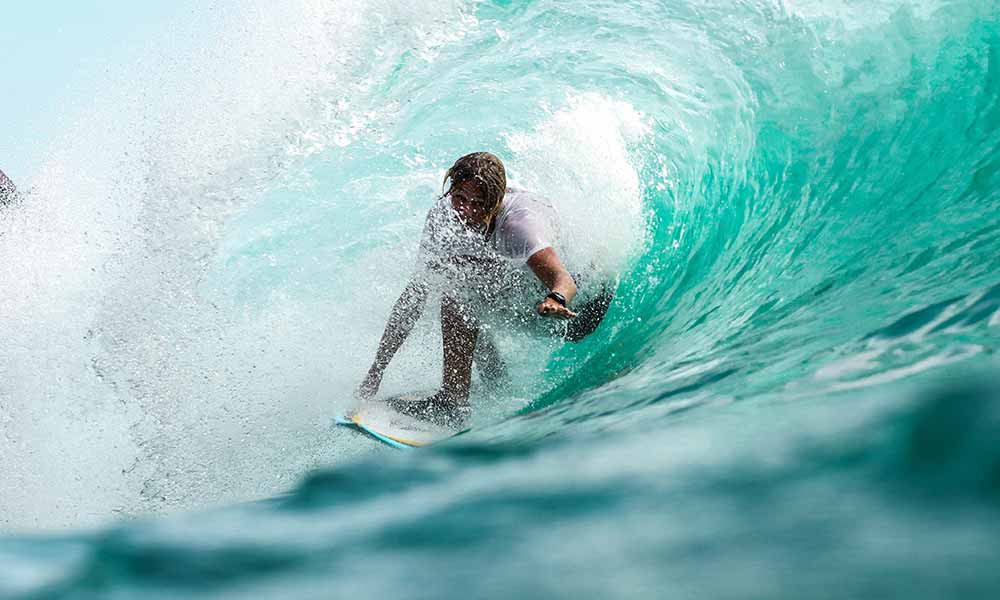Occasionally, you see a video of a pro surfer wearing a t-shirt ripping on a fun-looking head-high wave in the middle of the South Pacific. When we see this type of thing, we automatically assume someone dropped the ball and forgot a rash guard or a wetsuit top because surfing in a t-shirt is just a bad idea.
Let’s be clear as to why surfing in a t-shirt is a bad idea. T-shirts soak up water, restrict movement, are heavy to surf in, and are not designed to protect you from the sun’s harmful rays. There are better options like wetsuit tops and rash guards to do all of that.
Let’s get into why surfing in a t-shirt is a bad idea and why it could be a good idea in a pinch.
Can You Surf In A T-Shirt?
You can wear a t-shirt when surfing, we’ve done it. It’s uncomfortable. There is typically no good reason to wear a t-shirt when surfing when there are other better options like rash guards and wetsuit tops.
Surfing in A Shirt Vs A Rash Guard
There are very clear benefits when you compare surfing in a t-shirt vs surfing in a rash guard or wetsuit top.
| T-Shirt | Rash Guard | Wetsuit Top | |
| Provides sun protection | Some | Yes | Yes |
| Repels water | No | Yes | Yes |
| Soaks up water | Yes | No | No |
| Creates unnecessary weight | Yes | No | No |
| Creates drag | Yes | No | No |
| Dries fast | No | Yes | Yes |
| Keeps you warm | No | No | Yes |
| Provides padding to protect your ribs when paddling | No | No | Yes |
The Cons Of Wearing A T-Shirt When You Surf
The cons of wearing a t-shirt when you surf include the following.
Wearing a t-shirt:
- Won’t protect you from the sun like a rash guard or wetsuit top. They are simply not designed to do so.
- Will be heavy and restrict your movement. Most t-shirts are made of cotton or a cotton blend. They will soak up water and will add unnecessary weight.
- Won’t keep you warm. You are going to really feel the cold of the wind when it hits you if you are wearing a wet t-shirt.
- Will get soaked, stretched, and baggy which will create drag when you paddle and duck dive.
The Pros Of Wearing a T-Shirt When You Surf
If you have no other options, you could wear a t-shirt when surfing.
T-shirts can:
- Give you some protection from the sun, but they won’t protect you from the sun’s harmful rays like a rash guard or wetsuit top will. As a last resort wear a t-shirt.
- Provide some amount of protection from your surf wax to help you avoid rashes.
- Be worn underneath a wetsuit if you are in a pinch and you already have a rash from your wetsuit.
- Be helpful in keeping wax out of chest hair.
The biggest and only true pro of wearing a t-shirt when surfing is that they keep you cool during those very hot uncomfortable summer days when the sun is beating down on you, there is a heatwave, and the humidity is off the charts.
Still, given the functionality of rash guards, we would opt for a short-sleeved white rash guard to keep the sun off us and to give us a barrier of protection between us and the surfboard.
Alternatives To Wearing a T-Shirt When Surfing
If you don’t want to surf bareback, there are 2 alternatives to wearing a shirt when surfing.
They are:
- Rash Guards
- Wetsuit tops
Rash Guards
Rash Guards are made with spandex, nylon and/or polyester. They are designed to be form-fitting and come in a bunch of different colors.
They can be worn by themselves or under a wetsuit if you are sensitive to neoprene.
Rash guards are designed to protect you against rashes and harmful UV rays from the sun.
You can get short sleeve and long sleeve rash guards, and some even have a hood to protect your head.
Wetsuit Tops
Wetsuit tops are made of neoprene and give you added warmth and protection against rib bruising compared to just wearing a rash guard (or t-shirt) when you surf.
Summer wetsuit tops are typically 1, 1.5 or 2mm thick. They come in a few styles including the following and are available as pullovers and front zips:
- Wetsuit Vest – Vests cover your torso but leave your shoulders and arms exposed to the sun, air, and water. The neoprene of a vest is typically 1mm thick.
- Short-Sleeve Jackets – Short-sleeve jackets cover your torso and biceps like a typical t-shirt. The neoprene of a short sleeve jacket is typically 1.5mm thick.
- Long–Sleeve Jackets – Long-sleeve jackets cover your torso and your entire arm down to your wrists. The neoprene of a short sleeve jacket is typically 1mm or 2mm thick.
Conclusion
In a pinch, you could wear a t-shirt when you surf. However rash guards and wetsuit tops will help keep the sun and wind off of you and keep you more comfortable so you can surf longer and more comfortably.







